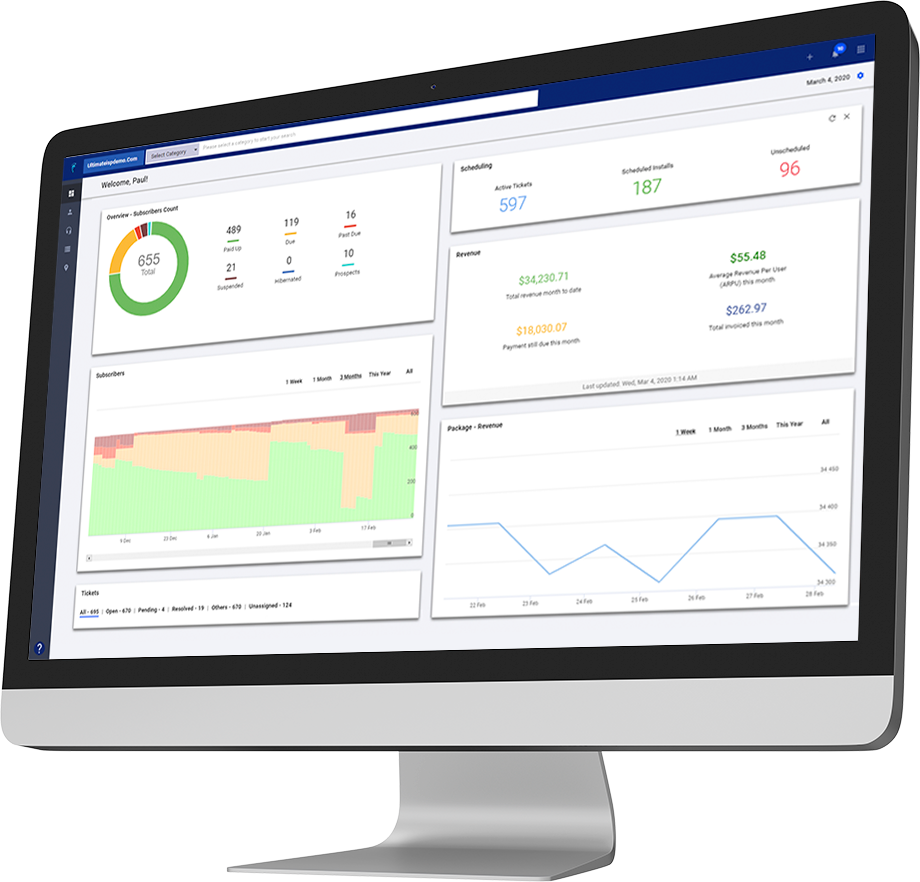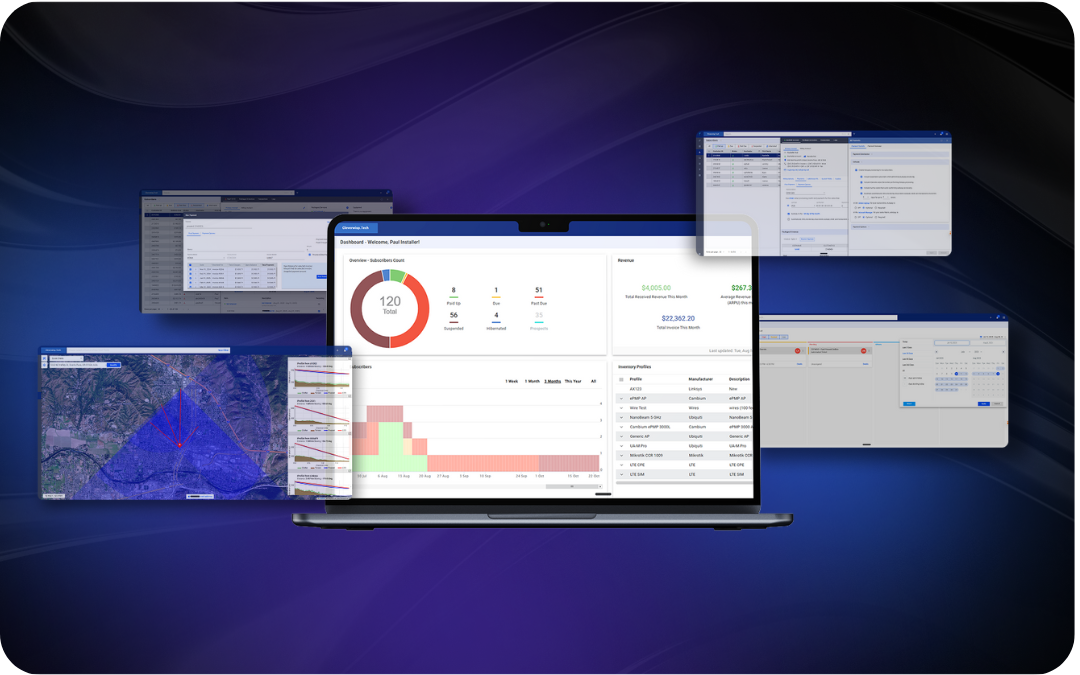Since its founding in 2002, Triad Wireless the WISP and wireless engineering consulting firm has built an impressive subscriber and project list throughout the southwest states. They provide broadband services in the greater Phoenix area, Tucson and other areas in southern Arizona.
The engineering arm of the organization contributed to large wireless projects like the World Market Center and Stratosphere Casino in Las Vegas, numerous RV Parks, airports, city-wide surveillance systems and more.
When Triad’s network administrator joined the successful business in 2015, the organization was mature with positive revenue flow. Despite continuous growth since its inception, the organization faced issues that are common to WISPs that rely on an outdated, manual billing process.
“We were taking payments manually and tracking them with Excel spreadsheets,” he explained. “Everyone had to manually add payments to a spreadsheet, update expired credit card expiration dates and change speed packages.”
The cost of wasted time is undeniable, but when the true cost of manual processes is calculated, it’s off the charts.
 The Real Cost of Disorganized Processes
The Real Cost of Disorganized Processes
Disorganized billing and tracking processes cost more than employee frustration — they increase the hours to complete essential tasks. A few minutes of unnecessary work adds up to a significant quantity of time over a year’s time.
It’s easy to calculate the cost. A survey asked employees how many hours automation would save them. They estimated 240-hours per year; executives estimated 360 hours[1]. Multiply the median salary of an accounts receivable clerk ($20 an hour)[2] to 240 and 360 hours to calculate the cost of wasted time over a year and you’ll arrive at $4,800 to $7,200 in wasted salary for one clerk.
Even more costly is the wasted hours that staff members won’t spend on more important tasks like tasks that support growth and expansion, and other profit-building activities.
Lack of Automation Results in Lost Revenue
When their servers failed, it led to thousands of dollars in lost revenue as well as a year’s worth of wasted time for Triad. “At one point, we lost the server, and no one was able to control speeds,” said the administrator. “Our customers got whatever speed they could, and we performed upgrades left and right.”
It took a year for Triad to get speed control on track and get subscribers to pay for the speeds they were using. “After we recovered from the server situation, it was clear that we needed a new billing system and automation systems that monitor subscribers’ internet use.”
Billing Systems Aren’t All Alike
The first billing and automation system vendor Triad hired let them down in a big way. After nine months, with half of Triad’s subscriber data imported into the software, the billing vendor went out of business without any warning. The company that bought the defunct billing vendor said that they’d be happy to keep Triad as a customer — at double the cost. It was time to go back to the drawing board.
Data Transparency = Paid Accounts
The Triad team searched for new billing providers by going on WISP-related social platforms, “We asked Facebook and Visp.net kept getting recommended — they just kept popping up.”
Before engaging Visp.net, Triad began going through their data to import, they found subscribers that had been activated and set up in the former billing system but had never been billed before.
“A business client was using our service and providing security for a data center, and they called up to cancel one of the service lines. But they had three lines,” the network administrator explained. “We closed the account and stopped billing the customer for their primary line, but they were still getting service for the remaining two lines of service. Had we implemented Visp earlier, they would have been shut off and never gotten away with free broadband because of a simple clerical error.”
Visp.net’s billing and automation system includes a feature that blocks access to internet service if a subscriber’s account goes past due beyond the grace period. When the past-due subscriber attempts to get online, a screen appears that states the account is past due and internet service will be restored when payment is made.
The subscriber is presented with a payment portal to make an online payment and internet service is automatically restored when payment is made online without staff intervention.
Better Control and Management Increases Profitability
Triad discovered an unexpected benefit after integrating Visp – they were able to delay a $100,000 backhaul project planned for the West Valley of Phoenix in early 2020.
“We upgraded to one gig during the summer of 2019 and in three months we hit the limit. We were looking to upgrade to two gigabytes at a $100k cost.. By implementing Visp, we saw an almost exact 50% cut in the internet being used in the area.”
The drop in bandwidth usage was related to streaming media and Visp’s ability to manage bandwidth use subscribers’ package limits, which limited use and improved internet flow.
“I attribute the better quality reports to the throttle function forcing a stream to conform to the customer’s speed package,” Triad’s network administrator explains. “The throttle eliminates the buffer most customers see when the stream selects a lower speed or quality during any disturbance to the connection.”
In addition to a drop in bandwidth usage, 95% of Triad’s customers reported a better quality of service. The administrator points to the system enforcing speed limits, especially when it comes to streaming media.
The remaining 5% of Triad’s subscribers had accounted for nearly half of their bandwidth usage. Of those customers, most switched to higher speed packages within a week and increased Triad’s revenue.
“The speed throttle function allows us to ensure customers are limited to the speed they pay for rather than the maximum capacity of the wireless links.”.
Currently, the area is at 700 mg usage and they plan to implement the backhaul project later in 2020, deferring the high dollar spend for months. And, with Visp’s billing system effectively tracking non-paying subscribers and blocking internet access until accounts are current, Triad is collecting more revenue.
“If we’re cutting bandwidth usage in half and collecting from previous non-payers, we’re twice as profitable.”
 Real-time Support Makes Migration Easier
Real-time Support Makes Migration Easier
Software integration and data migration are complicated, detailed processes and having a vendor’s support during these times makes it easier for the customer, saves their staff time and cost.
“Visp made it very easy to implement and use these features,” the engineer said. “Instead of having our technicians do it, we saved staff time and the money to pay the technicians.”
Conclusion
ISPs, FISPs and WISPs have a choice when it comes to billing – build a billing system themselves, use a free billing software, hire expensive contractors to build, update and manage a system for them, or integrate a billing and automation system with a long track record of success.
When this new system also reduces wasted time, serves as a gateway to lock down your internet so subscribers only get the broadband they pay for and manages the stream so every GB is managed, it makes a significant difference to the bottom line.
Could implementing Visp reduce time spent on disorganized billing processes? Catch freeloaders who are receiving internet services without paying for them? Lockdown internet flow to ensure package limits are enforced?
A “yes” answer could mean more cash in your pocket. Learn more about Visp’s billing and automation, client-driven development and top-notch customer service at visp.net or call 541.955.6900.
- KRC Research; WorkMarket 2020 (in)Sight Report; Fielded in April 2017; online: https://content.workmarket.com/2020-insight-report-what-ai-automation-mean-for-work/?utm_source=forbes&utm_medium=blog&utm_campaign=2017_automation_report&utm_content=home-page
- Salary.com; Hourly Wage for Accounts Receivable Clerk II in the United States: https://www.salary.com/research/salary/benchmark/accounts-receivable-clerk-ii-hourly-wages




 The Real Cost of Disorganized Processes
The Real Cost of Disorganized Processes







